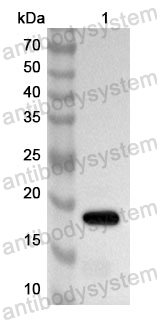Catalog No.
PHG81501
Species reactivity
Human
Host species
Rabbit
Isotype
IgG
Clonality
Polyclonal
Immunogen
E. coli - derived recombinant Human SCN5A (Ser1787-Gln1931).
Tested applications
ELISA: 1:4000-1:8000, IHC: 1:50-1:100, WB: 1:1000-1:4000
Target
Sodium channel protein type V subunit alpha, SCN5A, Sodium channel protein type 5 subunit alpha, hH1, Voltage-gated sodium channel subunit alpha Nav1.5, Sodium channel protein cardiac muscle subunit alpha
Purification
Purified by antigen affinity column.
Accession
Q14524
Applications
ELISA, IHC, WB
Form
Liquid
Storage buffer
0.01M PBS, pH 7.4, 50% Glycerol, 0.05% Proclin 300.
Stability and Storage
Use a manual defrost freezer and avoid repeated freeze thaw cycles. Store at 2 to 8°C for frequent use. Store at -20 to -80°C for twelve months from the date of receipt.
NaV1.5 autoantibodies in Brugada syndrome: pathogenetic implications., PMID:39078224
Change of voltage-gated sodium channel repertoire in skeletal muscle of a MuSK myasthenia gravis mouse model., PMID:38650308
In silico drug repurposing in COVID-19: A network-based analysis., PMID:34358753
iPSC-derived cardiomyocytes from patients with myotonic dystrophy type 1 have abnormal ion channel functions and slower conduction velocities., PMID:33510259
Lidocaine inhibits the metastatic potential of ovarian cancer by blocking NaV 1.5-mediated EMT and FAK/Paxillin signaling pathway., PMID:33280262
SCN5A gene variants as potential markers of the progression of chronic chagasic cardiac alterations., PMID:33137501
An autoantibody profile detects Brugada syndrome and identifies abnormally expressed myocardial proteins., PMID:32533187
Supramolecular clustering of the cardiac sodium channel Nav1.5 in HEK293F cells, with and without the auxiliary β3-subunit., PMID:31950564
Differential Inhibition of Nav1.7 and Neuropathic Pain by Hybridoma-Produced and Recombinant Monoclonal Antibodies that Target Nav1.7 : Differential activities of Nav1.7-targeting monoclonal antibodies., PMID:29333591
Changes in cardiac Nav1.5 expression, function, and acetylation by pan-histone deacetylase inhibitors., PMID:27638876
Congenital and childhood atrioventricular blocks: pathophysiology and contemporary management., PMID:27351174
Human genome meeting 2016 : Houston, TX, USA. 28 February - 2 March 2016., PMID:27294413
Sigma-1 receptors modulate neonatal Nav1.5 ion channels in breast cancer cell lines., PMID:27160185
Extracellular Matrix-Mediated Maturation of Human Pluripotent Stem Cell-Derived Cardiac Monolayer Structure and Electrophysiological Function., PMID:27069088
Expression and function of the Scn5a-encoded voltage-gated sodium channel NaV 1.5 in the rat jejunum., PMID:26459913
CaMKII Phosphorylation of Na(V)1.5: Novel in Vitro Sites Identified by Mass Spectrometry and Reduced S516 Phosphorylation in Human Heart Failure., PMID:25815641
Crystal structure and molecular imaging of the Nav channel β3 subunit indicates a trimeric assembly., PMID:24567321
Provocation of an autoimmune response to cardiac voltage-gated sodium channel NaV1.5 induces cardiac conduction defects in rats., PMID:23684688
TGF-β1, released by myofibroblasts, differentially regulates transcription and function of sodium and potassium channels in adult rat ventricular myocytes., PMID:23393573
A novel missense mutation, I890T, in the pore region of cardiac sodium channel causes Brugada syndrome., PMID:23308164
Mass spectrometry-based identification of native cardiac Nav1.5 channel α subunit phosphorylation sites., PMID:23092124
Parental electrocardiographic screening identifies a high degree of inheritance for congenital and childhood nonimmune isolated atrioventricular block., PMID:22899775
Reactive oxygen species suppress cardiac NaV1.5 expression through Foxo1., PMID:22400069
TGF-β1-mediated fibrosis and ion channel remodeling are key mechanisms in producing the sinus node dysfunction associated with SCN5A deficiency and aging., PMID:21493874
F 15845, a new blocker of the persistent sodium current prevents consequences of hypoxia in rat femoral artery., PMID:20735424
Tubulin polymerization modifies cardiac sodium channel expression and gating., PMID:19861310
Molecular pharmacology of voltage-gated sodium channel expression in metastatic disease: clinical potential of neonatal Nav1.5 in breast cancer., PMID:19835862
Scn3b knockout mice exhibit abnormal sino-atrial and cardiac conduction properties., PMID:19796257
Correlations between clinical and physiological consequences of the novel mutation R878C in a highly conserved pore residue in the cardiac Na+ channel., PMID:18616619
Heterozygous nonsense SCN5A mutation W822X explains a simultaneous sudden infant death syndrome., PMID:18551308
Regulation of caveolar cardiac sodium current by a single Gsalpha histidine residue., PMID:18281377
Localization of Na+ channel isoforms at the atrioventricular junction and atrioventricular node in the rat., PMID:16966585
The neonatal splice variant of Nav1.5 potentiates in vitro invasive behaviour of MDA-MB-231 human breast cancer cells., PMID:16838113
A novel polyclonal antibody specific for the Na(v)1.5 voltage-gated Na(+) channel 'neonatal' splice form., PMID:16111763
Voltage-gated sodium channel expression and potentiation of human breast cancer metastasis., PMID:16061851
Tyrosine-phosphorylated and nonphosphorylated sodium channel beta1 subunits are differentially localized in cardiac myocytes., PMID:15272007
The genetic origin of atrioventricular conduction disturbance in humans., PMID:12956334
Localization of Nav1.5 sodium channel protein in the mouse brain., PMID:12499865
SCN5A is expressed in human jejunal circular smooth muscle cells., PMID:12358675

